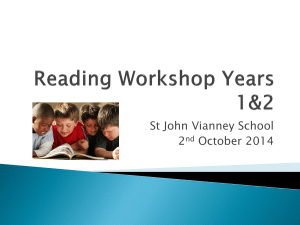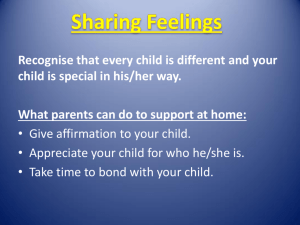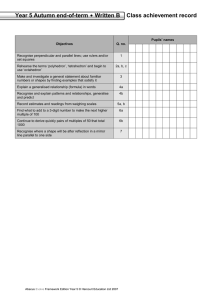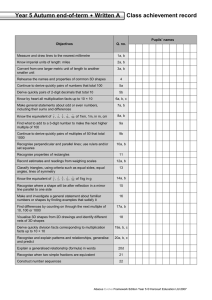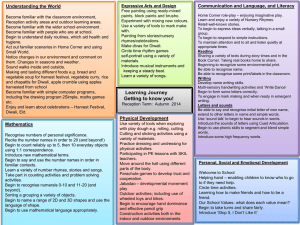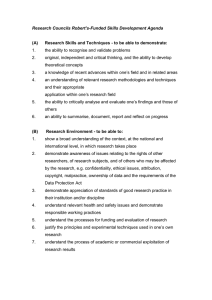Document 15649121
advertisement
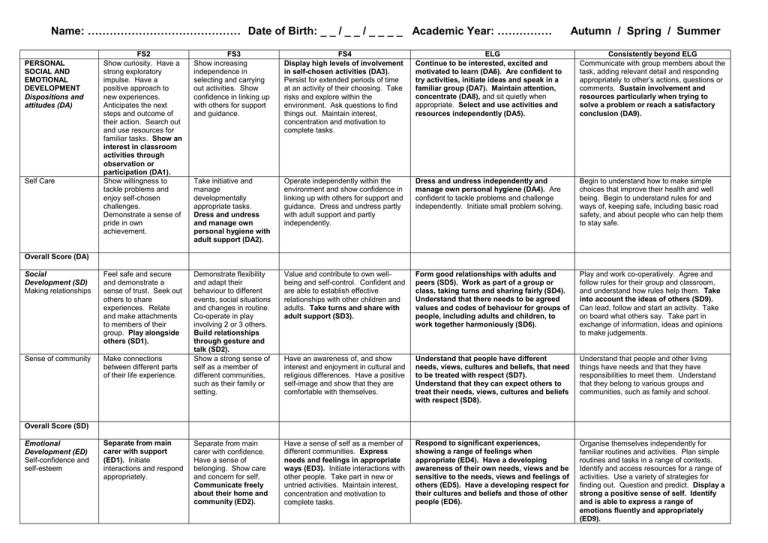
Name: …………………………………… Date of Birth: _ _ / _ _ / _ _ _ _ Academic Year: …………… Autumn / Spring / Summer FS2 Show curiosity. Have a strong exploratory impulse. Have a positive approach to new experiences. Anticipates the next steps and outcome of their action. Search out and use resources for familiar tasks. Show an interest in classroom activities through observation or participation (DA1). Show willingness to tackle problems and enjoy self-chosen challenges. Demonstrate a sense of pride in own achievement. FS3 Show increasing independence in selecting and carrying out activities. Show confidence in linking up with others for support and guidance. FS4 Display high levels of involvement in self-chosen activities (DA3). Persist for extended periods of time at an activity of their choosing. Take risks and explore within the environment. Ask questions to find things out. Maintain interest, concentration and motivation to complete tasks. ELG Continue to be interested, excited and motivated to learn (DA6). Are confident to try activities, initiate ideas and speak in a familiar group (DA7). Maintain attention, concentrate (DA8), and sit quietly when appropriate. Select and use activities and resources independently (DA5). Consistently beyond ELG Communicate with group members about the task, adding relevant detail and responding appropriately to other’s actions, questions or comments. Sustain involvement and resources particularly when trying to solve a problem or reach a satisfactory conclusion (DA9). Take initiative and manage developmentally appropriate tasks. Dress and undress and manage own personal hygiene with adult support (DA2). Operate independently within the environment and show confidence in linking up with others for support and guidance. Dress and undress partly with adult support and partly independently. Dress and undress independently and manage own personal hygiene (DA4). Are confident to tackle problems and challenge independently. Initiate small problem solving. Begin to understand how to make simple choices that improve their health and well being. Begin to understand rules for and ways of, keeping safe, including basic road safety, and about people who can help them to stay safe. Social Development (SD) Making relationships Feel safe and secure and demonstrate a sense of trust. Seek out others to share experiences. Relate and make attachments to members of their group. Play alongside others (SD1). Value and contribute to own wellbeing and self-control. Confident and are able to establish effective relationships with other children and adults. Take turns and share with adult support (SD3). Form good relationships with adults and peers (SD5). Work as part of a group or class, taking turns and sharing fairly (SD4). Understand that there needs to be agreed values and codes of behaviour for groups of people, including adults and children, to work together harmoniously (SD6). Play and work co-operatively. Agree and follow rules for their group and classroom, and understand how rules help them. Take into account the ideas of others (SD9). Can lead, follow and start an activity. Take on board what others say. Take part in exchange of information, ideas and opinions to make judgements. Sense of community Make connections between different parts of their life experience. Demonstrate flexibility and adapt their behaviour to different events, social situations and changes in routine. Co-operate in play involving 2 or 3 others. Build relationships through gesture and talk (SD2). Show a strong sense of self as a member of different communities, such as their family or setting. Have an awareness of, and show interest and enjoyment in cultural and religious differences. Have a positive self-image and show that they are comfortable with themselves. Understand that people have different needs, views, cultures and beliefs, that need to be treated with respect (SD7). Understand that they can expect others to treat their needs, views, cultures and beliefs with respect (SD8). Understand that people and other living things have needs and that they have responsibilities to meet them. Understand that they belong to various groups and communities, such as family and school. Separate from main carer with confidence. Have a sense of belonging. Show care and concern for self. Communicate freely about their home and community (ED2). Have a sense of self as a member of different communities. Express needs and feelings in appropriate ways (ED3). Initiate interactions with other people. Take part in new or untried activities. Maintain interest, concentration and motivation to complete tasks. Respond to significant experiences, showing a range of feelings when appropriate (ED4). Have a developing awareness of their own needs, views and be sensitive to the needs, views and feelings of others (ED5). Have a developing respect for their cultures and beliefs and those of other people (ED6). Organise themselves independently for familiar routines and activities. Plan simple routines and tasks in a range of contexts. Identify and access resources for a range of activities. Use a variety of strategies for finding out. Question and predict. Display a strong a positive sense of self. Identify and is able to express a range of emotions fluently and appropriately (ED9). PERSONAL SOCIAL AND EMOTIONAL DEVELOPMENT Dispositions and attitudes (DA) Self Care Overall Score (DA) Overall Score (SD) Emotional Development (ED) Self-confidence and self-esteem Separate from main carer with support (ED1). Initiate interactions and respond appropriately. Behaviour and selfcontrol FS2 Begin to accept the needs of others, with support. FS3 Show care and concern for others, for living things and the environment. FS4 Show confidence and the ability to stand up for own rights. Have an awareness of the boundaries set and behavioural expectations within the setting. ELG Understand what is right, what is wrong, and why (ED8). Consider the consequences of their words and actions for themselves and others (ED7). Consistently beyond ELG Recognise that their behaviour affects other people. Use words and/or gestures, including body language such as eye contact and facial expression to communicate. Listen and respond (LCT1). Listen to favourite nursery rhymes, stories and songs. Join in with repeated refrains, anticipating key events and important phrases. Respond to simple instructions with up to 2 key words. Listen to others in one-toone/small groups when conversation interests them. Use familiar words, often in isolation, to identify what they do and do not want. Use vocabulary focused on objects and people who are of particular importance to them. Use isolated words and phrases and/or gestures to communicate with those well known to them. Use simple statements and questions often linked to gestures. Use intonation, rhythm and phrasing to make their meaning clear to others. Interact verbally with other people. Understand and follow simple instructions. Initiate communication with others, displaying greater confidence in more informal contexts (LCT2). Listen to stories with increasing attention and recall. Know some songs, rhymes and stories and take part in role-play. Describe main story settings, events and principal characters. Question why things happen, and give explanations. Build up the vocabulary that reflects the breadth of their experiences. Begin to experiment with language describing possession. Begin to use more complex sentences. Use a widening range of words to express or elaborate ideas. Have emerging self-confidence to speak to others about wants and interests. Use simple grammatical structures. Ask simple questions, often in the form of ‘where’ or ‘what’. Talk alongside others, rather than with them. Use talk to gain attention and initiate exchanges. Use action rather than talk to demonstrate or explain to others. Initiate conversation, attend to and take account of what others say, and use talk to resolve disagreements. Initiate a conversation, negotiate positions, pay attention to and take account of others’ views. Use language to make up own stories and develop imaginative role-play. Participate as a speaker and listener in a variety of situations. Explore and experiment with new sounds and words. Extend vocabulary, especially by grouping and naming. Use vocabulary and forms of speech that are increasingly influenced by experience of books. Link statements and stick to a main theme of intention. Consistently develop a simple story, explanation or line of questioning. Use language for an increasing range of purposes. Confidently talk to people other than those who are well known to them. Interact with others in a variety of contexts (LCT6), negotiating plans and activities and taking turns in conversation. Understand and use a wide and varied vocabulary. Enjoy listening to and using spoken and written language, and readily turn to it in their play and learning. Listen with enjoyment, to stories, rhymes and poems. Sustain attentive listening and respond with relevant comments, questions or actions (LCT4). Make up their own stories, songs, rhymes and poems. Extend their vocabulary, exploring the meanings and sounds of new words. Speak clearly and audibly with confidence and control and show awareness of the listener (LCT8) for example by their use of conventions such as greetings, ‘please’ and ‘thank you’. Talk about matters ot interest to individuals and groups. Convey meaning, making their contribution relevant and interesting to the listeners. Sustain a topic of conversation in a group and with individuals, extending ideas or accounts by providing detail. Describe and sequence events fluently and accurately, conveying meaning to a range of listeners, speaking audibly. Participate as a speaker and listener in a variety of structured and unstructured situations, using language appropriately. Follow, with understanding, what others say, and respond appropriately. Talk and listen confidently and with control, consistently showing awareness of the listener by including relevant detail (LCT9a). Overall Score (ED) COMMUNICATION, LANGUAGE AND LITERACY Language for communication and thinking (LCT) Language for communication Language for thinking FS2 Use action, sometimes with limited talk, that is largely concerned with the ‘here and now’. FS3 Use talk to give new meanings to objects and actions, treating them as symbols for other things. Use talk to connect ideas, explain what is happening and anticipate what might happen next. Use talk, actions and objects to recall and relive past experience. FS4 Begin to use talk instead of action to rehearse, reorder and reflect on past experience, linking significant events from own experience and from stories, paying attention to sequence and how events lead into one another. Begin to make patterns in their experience through linking cause and effect, sequencing, ordering, and grouping. Begin to use talk to pretend, imaginary situations. In small and large groups listens attentively and respond to discussion, longer stories, poems, songs and explanations. Are aware of rhyme and alliteration, makes up own rhymes and stories. Talk activities through, reflecting on and modifying actions (LCT3). ELG Use language to imagine and recreate roles and experiences (LCT5). Use talk to organise, sequence and clarify thinking, ideas, feelings and events, exploring the meaning and sounds of new words (LCT7). Consistently beyond ELG Begin to use thinking skills to learn how to learn. Use language to work out and clarify ideas, showing control or a range of appropriate vocabulary (LCT9b). Enjoy and join in with rhyming and rhythmic activities (LSL1). Distinguish one sound from another. Show awareness of rhyme and alliteration (LSL2). Recognise rhythm in spoken words. Continue a rhyming string. Hear and say the initial sound in words and know which letters represent some of the sounds. Link some sounds to letters (LSL3). Hear and say initial and final sounds in words (LSL5). Link sounds to letters, naming and sounding the letters of the alphabet (LSL4). Hear and say short vowel sounds within words (LSL6). Use phonic knowledge to read simple regular words (LSL7). Attempt to read more complex words, using phonic knowledge (LSL8). Use their phonic knowledge to write simple regular words and make phonetically plausible attempts at more complex words. Use their knowledge of letters, sounds and words to read simple texts with meaning. Use knowledge of letters, sounds and words when reading and writing independently (LSL9). Listen to and join with stories and poems, one-to-one and also in small groups. Are developing interest in illustrations and print in books and print in the environment (R1). Begin to be aware of the way stories are structured. Can choose books they know and enjoy. Turn pages appropriately. Know that print conveys meaning (R2). Have favourite books. Handle books carefully. Suggest how the story might end. Know information can be relayed in the form of print. Look at books and talk about the pictures, turning pages one at a time. Anticipate words or recognise an omission when listening to familiar stories. Recognise own name in print. Understand the concept of a word. Enjoy an increasing range of books and handle them carefully, understanding how they are organised. Recognise a few familiar words (R3). Know that information can be retrieved from books and computers. Express their response to familiar texts by identifying aspects they like and dislike. Recognise familiar individual words in responding to books and print. Explore and experiment with sounds, words and texts. Retell narratives in the correct sequence, drawing on language patterns of stories (R7). Read a range of familiar and common words and simple sentences independently (R6). Know that English, is read from left to right and top to bottom (R4). Show an understanding of the elements of stories, such as main character, sequence of events, and openings (R5), and how information can be found in non-fiction texts to answer questions about where, who, why and how (R8) Read to an adult, simple personal and/or published books of own choice with some fluency and accuracy (R9). Talk about characters, events or ideas in stories, poems and non-fiction. Express their personal response and understand how information can be found in non-fiction texts to answer questions. Use books for information. Overall Score (LCT) Linking sounds and letters (LSL) Overall Score (LSL) Reading (R) Overall Score (R) Writing (W) Handwriting FS2 Experiment with mark-making, sometimes ascribing meaning to the marks (W1). FS3 Copy and make patterns. Enjoy using writing materials. Draw pictures. Use some clearly identifiable letters to communicate meaning (W2). FS4 Begin to break the flow of speech into words. Use writing as a means of recording and communicating. Use letters, words or phrases to communicate meaning. Can write first name. Sometimes use their knowledge of letter sounds in own writing. Represent some sounds correctly in writing (W3). Show awareness of some of the different forms and purposes of writing. Begin to use anticlockwise movement and retrace vertical lines. Begin to form recognisable letters. Pictures and patterns are more detailed. ELG Use their phonic knowledge to write simple regular words and make phonetically plausible attempts at more complex words (W7). Attempt writing for a variety of purposes, using features of different forms (W6) such as lists, stories and instructions. Write their own names and other words from memory (W4). Begin to write labels and form captions and, begin to form simple sentences, sometimes using punctuation (W8). Draw with detail and accuracy. Hold a pencil and use it effectively to form recognisable letters, most of which are correctly formed (W5). Consistently beyond ELG Write simple words, phrases and simple sentences, making some use of punctuation. Some words spelt conventionally, prepared to attempt more complex words based on phonic knowledge. Make some choice of appropriate vocabulary. Write unaided in simple sentences. Communicate meaning through phrases and simple sentences with some consistency in punctuating sentences (W9). Engage in activities requiring hand-eye co-ordination. Use tools and equipment, one handledly. Draw lines, circles and crosses using gross motor movement. Manipulate objects with increasing control. Show an interest in numbers and counting. Use some number names and vocabulary spontaneously. Enjoy joining in with number rhymes and songs. Use mathematical language in play. Is aware of numbers in everyday life. Say some number names in familiar contexts such as nursery rhymes (NLC1). Show curiosity about numbers by offering comments or asking questions. Use some number names accurately in play. Willingly attempt to count, with some numbers in the correct order. Recognise groups with one, two or three objects. Count reliably up to 3 everyday objects (NLC2). Show confidence with numbers by initiating or requesting number activities. Compare, sort, match and sequence familiar objects. Recognise some numerals of personal significance. Begin to represent numbers using fingers, marks on paper or pictures. Recognise numerals 1 to 5. Select the correct numeral to represent 1 to 5 objects. Count reliably up to 6 objects from a large group (NLC3). Count actions or objects that cannot be moved. Show increased confidence with numbers by spotting errors. Count an irregular arrangement of up to 10 objects. Say the number after any number up to 9. Begin to count beyond 10. Begin to use ordinal numbers. Display mathematical understanding through talk and play, solving simple practical problems. Say and use number names in order in familiar contexts (NLC4). Count reliably up to 10 everyday objects (NLC6). Recognise numerals 1 to 9 (NLC5). Order numbers up to 10 (NLC7). Use developing mathematical ideas and methods to solve practical problems (NLC8). Sort and classify objects. Play number games. Use ordinal numbers. Displays some mathematical understanding, verbally. Recognise 0 as zero or none when counting or ordering. Read and write the numbers involved. Use maths as a integral part pf classroom activities. Use mathematical language when solving practical problems. Begin to use familiar maths language. Recognise, count, order and write numerals up to 20 (NLC9). Compare two groups of objects, saying when they have the same number. Respond to the vocabulary involved in addition and subtraction in rhymes and games (C1). Show an interest in number problems. Separate a group of three or four objects in different ways, beginning to recognise that the total is still the same. Use coins in play shopping. Recognise differences in quantity when comparing sets of objects (C2). Sometimes show confidence and offer solutions to problems. Find the total number of items in two groups by counting all of them. Use own methods to solve a problem. Say with confidence the number that is one more than a given number. Recognise and name some coins. Find one more or one less from a group of up to 5 objects (C3). In practical activities and discussion begin to use the vocabulary involved in adding and subtracting (C6). Use language such as more, less, greater, smaller, to compare two numbers or quantities. Find one more or one less than a number from 1 to 10 (C7). Relate addition to combining two groups of objects (C4) and subtracting to ‘taking away’ (C5). Use developing mathematical ideas and methods to solve practical problems (C8). Add, and subtract numbers when solving problems involving up to 10 objects. Use a range of strategies for addition and subtraction, including some mental recall of number bonds (C9). Develop a legible writing style. Understand the importance of clear and neat presentation in order to communicate meaning effectively. Overall Score (W) MATHEMATICAL DEVELOPMENT Numbers as labels and for counting (NLC) Overall Score (NLC) Calculating (C) Overall Score (C) Shape, space and measures (SSM) FS2 Show an interest in shape and space by playing with shapes or making arrangements with objects. Show awareness of similarities in shapes in the environment. Observe and use positional language. Use size language such as ‘big’ and ‘little’. Talk about the shapes of everyday objects. Compare one object to another according to size or length. Experiment with a range of objects and materials showing some mathematical awareness (SSM1). FS3 Show interest by sustained construction activity or by talking about shapes or arrangements. Use shapes appropriately for tasks. Begin to talk about the shapes of everyday objects. Order 2 or 3 items by: length; weight; capacity. Copy 2 part patterns. Explore properties of objects and shapes. Use familiar words to describe position, size and measure. Sort or match objects and talk about sorting (SSM2). FS4 Make comparisons of position, shapes, size, patterns, quantity, length and mass. Sustain interest for a length of time on a pre-decided construction or arrangement. Match some shapes by recognising similarities and orientation. Use appropriate shapes to make representational models or more elaborate pictures. Show curiosity and observation by talking about shapes, how they are the same or why some are different. Find items from positional/directional clues. Describe a simple journey. Choose suitable components to make a particular model. Adapt shapes or cut material to size. Select a particular named shape. Begin to use mathematical names for ‘solid’ 3D shapes and ‘flat’ 2D shapes and mathematical terms to describe shapes. Describe shapes in simple models, pictures and patterns (SSM3). Show awareness of symmetry. Order 2 or 3 items by length ot height. Order 2 items by weight or capacity. Beginning to know simple terms relating to time; (morning, night). ELG Use language such as ‘greater’, ‘smaller’, ‘heavier’ or ‘lighter’ to compare quantities (SSM7). Talk about, recognise and recreate simple patterns (SSM4). Use language such as ‘circle’ or ‘bigger’ to describe the shape and size of solids and flat shapes (SSM6). Use everyday words to describe position (SSM5). Use developing mathematical ideas and methods to solve practical problems (SSM8). Consistently beyond ELG Describe position. Recognise and name some common 3D shapes and describe their properties. Measure and order objects using direct comparison. Recognise and use a simple patter or relationship. Represent their work with objects or pictures and discuss it. Logically, order everyday events and begin to use the vocabulary of time. Use mathematical language to describe solid (3D) objects and flat (2D) shapes (SSM9). Show curiosity and interest by facial expression, movement or sound, Can find 2 of the same colour. Knows name and age. Explores objects, natural features, animals and plants, and can name some of them. Shows an interest in why things happen and how things work. Show curiosity and interest by exploring surroundings (KUW1). Observe, select and manipulate objects and materials. Identify simple features and significant personal events (KUW2). Recognise and name primary colours. Sort objects by one function. Talk about what is seen and what is happening. Examine objects and living things to find out more about them and ask questions. Identify obvious similarities and differences when exploring and observing (KUW3a). Notice and comment on patterns. Show an awareness of change. Investigate places, objects and materials by using all of their senses as appropriate. Identify some features and talk about those features they like and dislike (KUW4). Look closely at similarities, differences, patterns and change. Ask questions about why things happen and how things work (KUW5). Communicate simple planning for investigations and constructions and make simple records and evaluations of their work. Identify and name key features and properties, sometimes linking different experiences, observations and events (KUW9a). Recognise, name and describe a range of common animals, external parts of the body and plants. Know about a range of properties of materials. Communicate observations of changes in light, sound or movement that result from actions. Recognise that sound and light come from a variety of sources and name some of them. Overall Score (SSM) KNOWLEDGE AND UNDERSTANDING OF THE WORLD (KUW) Exploration and investigation FS2 Investigate construction materials. Realise tools can be used for a purpose. Attempt to use scissors. FS3 Join construction pieces together to build and balance. Begin to try out a range of tools and techniques safely. FS4 Construct in a purposeful way, using a variety of resources, simple tools and techniques competently and appropriately (KUW3b). Information and communication technology Show an interest in ICT. Able to make simple toys work. Know how to operate simple equipment. Complete a simple program on the computer and/or perform simple functions on ICT apparatus. Sense of time Remember and talk about significant things that have happened to them. Examine events to find out more about them and ask questions. Begin to know order of days of the week, yesterday and tomorrow. Sense of place Show an interest in the world in which they live. Cultures and beliefs Express feelings about a significant personal event. Show interest in the lives of people familiar to them. Begin to differentiate between past and present. Comment and ask questions about where they live and the natural world. Notice differences between features of the local environment. Describe significant events for family or friends. Differentiate marks and movements on paper. Begin to describe the texture of things. Use lines to enclose a space, then begin to use these shapes to represent objects. Begin to construct, stacking blocks vertically and horizontally, making enclosures and creating spaces. Use a widening range of materials and equipment to explore and experiment. Interested in mixing colours and using textures. Designing and making skills ELG Select the tools and techniques they need to shape, assemble and join materials they are using. Build and construct with a wide range of objects, selecting appropriate resources, and adapting their work where necessary (KUW8). Find out about and identify the uses of everyday technology and use information and communication technology and programmable toys to support their learning (KUW7). Find out about past and present events in their own lives, and in those of their families and other people they know (KUW6a). Beginning to know sequences of time; months of the year and seasons. Observe, find out about and identify features in the place they live and the natural world. Find out about their environment, and talk about those features they like and dislike. Consistently beyond ELG Explore and use information from various sources and in different forms. Generate ideas and recognise characteristics of familiar products. Make plans to show how ideas can be put into practice. Talk about their own and other people’s work. Describe how a product works. Use ICT to work with text, images and sound to share ideas. Able to use everyday devices that respond to signals and instructions. Gain an awareness of the cultures and beliefs of others. Begin to know about their own cultures and beliefs and those of other people (KUW6b). Begin to explore what it means to belong to a variety of groups and communities (KUW9b). Explore what happens when they mix colours. Understand that different media can be combined. Make constructions, collages, paintings, drawings and dances. Use ideas involving fitting, overlapping, in, out, enclosure, grids and sun-like shapes. Choose particular colours to use for a purpose. Experiment to create different textures. Work creatively to a large or small scale. Explore colour, texture, shape, form and space in 2 or 3 dimensions (CD5). Use a variety of materials and processes to communicate their ideas and meaning. Describe what they think and feel about their own and other people’s work. Design and make images and artefacts. Know own address and telephone number. Can talk about where they live and their environment. Recognise distinction between present and past in own and other people’s lives. Show an emerging sense of chronology. Know episodes from stories about the past. Recognise and make observations about physical and human features of localities, expressing views about them. Ask and respond to questions about places and environments. Overall Score (KUW) CREATIVE DEVELOPMENT (CD) Exploring media and materials Begin to differentiate colours. Use their bodies to explore texture and space. Make 3-dimensional structures. Explore using a range of senses. Use colour and line to represent. Explore different media and respond to a variety of sensory experiences (CD1a). Music FS2 Join in favourite songs. Show an interest in the way musical instruments sound. Respond to sound with body movement. Enjoy joining in with dancing and ring games. Begin to move rhythmically. Imagination Pretend that one object represents another, especially when objects have characteristics in common. Notice what adults do, imitating what is observed and then doing it spontaneously when the adult is not there. Engage in representational play (CD1b). Sequence actions to enact observed behaviours, Responding to experiences, and expressing and communicating ideas Show an interest in what they see, hear, smell, touch and feel. Use body language, gestures, facial expression or words to indicate personal satisfaction or frustration. FS3 Sing a few simple, familiar songs. Sing to themselves and make up simple songs. Tap out simple repeated rhythms and make some up. Explore and learn how sounds can be changed. Imitate and create movement in response to music. Engages in music making (CD2a). Use one object to represent another, even when the objects have few characteristics in common. Use available resources to create props to support roleplay. Develop a repertoire of actions by putting a sequence of movements together. Enjoy stories based on themselves and people and places they know well. Engage in imaginative and roleplay based on own firsthand experiences. Further explore an experience using a range of senses. Describe experiences and past actions, using a widening range of materials. Create simple representations of events, people and objects (CD2b). FS4 Begin to build up a repertoire of songs. Explore the different sounds of instruments. Copy simple repeated rhythms and make some up. Understand that instruments make sounds in different ways. Initiate and create movement in response to music. ELG Sing simple songs from memory (CD4). Recognise and explore how sounds can be changed. Recognise repeated sounds and sound patterns and match movements to music (CD6). Consistently beyond ELG Recognise and explore how sounds can be made and changed. Respond to different moods in music. Use their voices in different ways. Create and choose sounds and repeat and identify short patterns. Recognise changes in sound and simple patterns. Introduce a story line or narrative into their play. Play alongside other children who are engaged in the same theme. Play co-operatively as part of a group to act out a narrative. Use their imagination in art and design, music, dance, imaginative and role-play and stories (CD7a). Express feelings, preferences in response to artwork, drama and music and makes comparisons and links between different pieces. Responds to own work and that of others when exploring and communicating ideas, feelings and preferences through art, music, dance, role-play and imaginative play (CD9). Try to capture experiences using a variety of different media (CD3). Respond with music, dance, paint and other materials or words. Develop preferences for forms of expression. Talk about personal intentions, describing what they were trying to do. Respond to comments and questions, entering into dialogue about their creations. Make comparisons. Respond in a variety of ways to what they see, hear, smell, touch and feel (CD7b). Express and communicate their ideas, thoughts and feelings by using a widening range of materials, suitable tools, imaginative and role-play, movement, designing and making, and a variety of songs and musical instruments (CD8). Show respect for other children’s personal space when playing among them. Persevere in repeating some actions/attempts when developing a new skill. Collaborate in devising and sharing tasks, including those, which involve accepting rules. Move body position as necessary. Show a clear and consistent preference for the left or right hand. Show awareness of space, of themselves and of others. Overall Score (CD) PHYSICAL DEVELOPMENT (PD) Sense of space Negotiate an appropriate pathway when walking, running or using a wheelchair or other mobility aids, both indoors and outdoors. Judge body space in relation to spaces available when fitting into confined spaces or negotiating holes and boundaries. Talk about how to exercise safely. PHYSICAL DEVELOPMENT (PD) continued Movement Health and bodily awareness Using equipment Using tools and materials Overall Score (PD) FS2 Move spontaneously within available space showing some control and co-ordination (PD1). Respond to rhythm, music and story by means of gesture and movement. Can stop with control. Manage body to create intended movements. Combine and repeat a range of movements. Developing control over mark making, construction and small world activities. Show awareness of own needs with regard to eating, sleeping and hygiene. Often need adult support to meet those needs. Operate equipment by means of pushing and pulling movements. Engage in activities requiring hand-eye co-ordination. Use one-handed tools and equipment. FS3 Move freely with pleasure and confidence, in a range of ways, showing some awareness of space (PD2), (such as slithering, shuffling, rolling, crawling, walking, running, jumping, skipping, sliding and hopping). Use movement to express feelings. Adjust speed or change direction to avoid obstacles. Negotiate space successfully when playing racing and chasing games with other children. Sit up, stand up and balance on various parts of the body. Demonstrate the control necessary to hold a shape or fixed position. Mount stairs, steps or climbing equipment using alternate feet. Increasing skill with activities requiring hand-eye co-ordination. Show awareness of a range of healthy practices with regard to eating, sleeping and hygiene. Observe the effects of activity on their bodies. FS4 Go backwards and sideways as well as forwards. Experiment with different ways of moving. Initiate new combinations of movement and gesture in order to express and respond to feelings, ideas and experiences. Jump off an object and land appropriately. Control speed and direction of movement in shared space. Usually show appropriate control in large and small-scale movements (PD3). Manipulate materials and objects by picking up, releasing, arranging, threading and posting them. Show increasing control over clothing and fastenings. ELG Move with confidence, imagination and in safety (PD4a). Can work co-operatively with partner. Use small and large equipment, showing a range of basic skills (PD6). Move with control and co-ordination. Travel around, under, over and through balancing and climbing equipment. Show awareness of space, of self and others (PD4b). Consistently beyond ELG Copy, repeat and explore simple skills and actions with basic control and co-ordination. Starting to link skills and actions in ways that suit that activity. Repeat links and adapt simple movements, sometimes commenting on their work. Demonstrate co-ordination and control in large and small movement (PD9a). Show some understanding that good practices with regard to exercise, eating, sleeping and hygiene can contribute to good health. Recognise the importance of keeping healthy and those things, which contribute to this. Recognise the changes that happen to their bodies when they are active (PD8). Talk about how their bodies feel during an activity. Construct with large materials such as cartons, long lengths of fabric and planks. Show increasing control in using equipment for climbing, scrambling, sliding and swinging. Demonstrate increasing skill and control in the use of markmaking implements, blocks, construction sets, and ‘small world’ activities. Understand that equipment and tools have to be used safely. Use increasing control over an object by touching, pushing, patting, throwing, catching or kicking it. Retrieve, collect and catch objects. Use a range of small and large equipment. Demonstrate fine motor control and coordination (PD5). Demonstrate co-ordination and control using a range of tools and equipment (PD9b). Explore malleable materials by patting, stroking, poking, squeezing, pinching and twisting. Manipulate materials to achieve a planned effect. Use simple tools to effect changes to the materials. Show understanding of how to transport and store equipment safely. Practise some appropriate safety measures without direct supervision. Handle tools, objects, construction and malleable materials safely and with basic increasing control (PD7).
